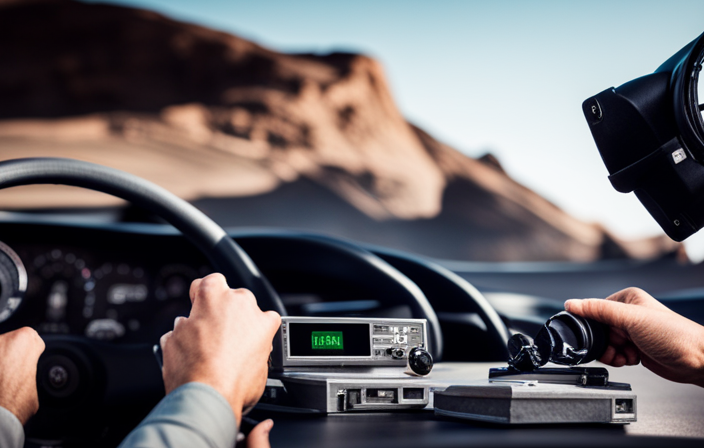The adage, “Every problem has a solution,” especially applies to repairing a malfunctioning adaptive cruise control system.
Hi, I’m here to guide you through the process of troubleshooting and resolving issues with your adaptive cruise control. Whether you’re experiencing error messages, warning lights, or simply a malfunctioning system, don’t worry, I’ve got you covered.
In this article, we will delve into the basics of adaptive cruise control, provide step-by-step instructions on how to diagnose and fix common faults, and offer valuable tips to prevent future issues.
So, let’s roll up our sleeves, put on our problem-solving hats, and get ready to take control of your adaptive cruise system. Because with the right knowledge and a little bit of effort, you’ll be cruising smoothly down the road in no time.
Key Takeaways
- Troubleshooting adaptive cruise control faults should be done by following provided instructions and contacting a professional mechanic or dealer for assistance.
- Proper maintenance practices, such as regularly inspecting and cleaning sensors, checking for loose connections or damaged wiring, and keeping the system updated with the latest software and firmware, can help prevent future issues.
- Consulting a professional mechanic or dealer is beneficial as they have expertise in diagnosing and fixing faults, provide thorough and accurate assessments, and can offer specific recommendations for certain makes or models.
- Providing detailed information about the problem, including error codes or warning lights displayed, helps mechanics or dealers troubleshoot more efficiently and ensures a correct resolution.
Understand the Basics of Adaptive Cruise Control
To fix an adaptive cruise fault, it’s important to understand the basics of how adaptive cruise control works. Adaptive cruise control, or ACC, is a feature in modern vehicles that uses radar or sensors to automatically maintain a safe distance from the vehicle ahead.
The benefits of adaptive cruise control are numerous. It not only reduces driver fatigue by automatically adjusting the speed, but it also enhances safety by preventing rear-end collisions.
ACC works by constantly monitoring the distance and speed of the vehicle in front. It uses this information to automatically adjust the throttle and brakes to maintain a safe following distance.
To fix an adaptive cruise fault, the first step is to check for error messages or warning lights, which will provide valuable information about the issue at hand.
Check for Error Messages or Warning Lights
First, keep an eye out for any error messages or warning lights that might pop up on your dashboard. These can provide valuable clues about the specific issue with your adaptive cruise control.
Here are some troubleshooting tips to help you understand common error codes:
- Look for error codes related to the adaptive cruise control system, such as ‘ACC Malfunction’ or ‘ACC Sensor Blocked.’
- Take note of any warning lights that indicate a problem, such as the ‘Check Engine’ light or the ‘Cruise Control’ light.
- Consult your vehicle’s manual or online resources to understand the meaning behind the specific error codes or warning lights.
- Consider visiting a professional mechanic or dealership if you are unsure about the significance of the error messages or warning lights.
Once you have checked for error messages or warning lights, it’s time to inspect the sensor area for obstructions.
Inspect the Sensor Area for Obstructions
To ensure smooth operation of your vehicle’s adaptive cruise control, it’s important to inspect the sensor area for any potential obstructions. Here’s what you need to do:
-
Visually examine the hardware surrounding the sensor, including the bumper and grille. Look for any signs of damage or debris that could interfere with the sensor’s functionality.
-
Check for any loose or disconnected connections that may be affecting the sensor’s performance.
If everything appears intact, you can proceed to troubleshooting techniques. These may involve resetting the system, checking for software updates, or consulting the vehicle’s manual for specific instructions.
By inspecting the sensor area and utilizing troubleshooting techniques, you can effectively diagnose and address any potential issues with your adaptive cruise control system. This will help ensure optimal performance and safety on the road.
Now, let’s move on to the next step: cleaning the sensor area.
Clean the Sensor Area
Before we can get our adaptive cruise control system back on track, let’s give the sensor area a good cleaning to ensure it’s free from any dirt or grime. Here are some cleaning techniques and troubleshooting tips to help you with the task:
-
Use a soft, lint-free cloth to gently wipe the sensor area. Avoid using abrasive materials that could scratch the surface.
-
If there are stubborn stains or debris, dampen the cloth with a mild cleaning solution and carefully wipe the area.
-
Pay close attention to the edges and corners of the sensor area, as dirt can accumulate there.
-
After cleaning, inspect the sensor area again to make sure it’s spotless and ready for operation.
With a clean sensor area, we can now move on to the next step of resetting the adaptive cruise control system.
Reset the Adaptive Cruise Control System
Now that we’ve given the sensor area a good cleaning, it’s time to reset the adaptive cruise control system. This can help resolve any faults or issues that may have occurred.
The exact resetting procedures can vary depending on the make and model of your vehicle, so it’s important to consult your vehicle’s manual for specific instructions. Generally, the process involves locating the cruise control button on your steering wheel or dashboard and holding it down for a few seconds until you see a confirmation message on your display.
If the fault persists after the reset, it may be necessary to move on to other troubleshooting techniques or check for software updates in order to resolve the issue.
Check for Software Updates
If you want to ensure your vehicle’s performance is at its best, it’s worth checking if there are any software updates available for your cruise control system. Updating the software can bring several benefits, including improved functionality, enhanced safety features, and troubleshooting common software issues. To check for software updates, you can refer to your vehicle’s user manual or visit the manufacturer’s website. It is important to follow the instructions carefully and ensure that you have the correct software version for your specific vehicle model. Once the update is complete, you can test the system on different road conditions to ensure its optimal performance. This will help you identify any remaining faults or issues that may need further attention.
Test the System on Different Road Conditions
Take your vehicle out for a spin on various road conditions to put the cruise control system to the test and ensure its optimal performance. It is important to test the adaptive cruise control system on different road conditions to evaluate its accuracy and performance. This will help you determine if the system is working properly and if any adjustments need to be made.
-
Test the system on smooth, straight roads to see how well it maintains a set speed and keeps a safe distance from the vehicle ahead.
-
Try it on hilly or mountainous terrains to assess its ability to adjust speed and maintain a safe following distance in different elevations.
-
Experiment with different weather conditions, such as rain or snow, to see if the system reacts appropriately and adjusts speed accordingly.
By testing the adaptive cruise control system on various road conditions, you can ensure its accuracy and evaluate its performance. If any issues arise during testing, consult the vehicle’s manual or manufacturer’s website for further guidance.
Consult the Vehicle’s Manual or Manufacturer’s Website
Refer to the vehicle’s manual or manufacturer’s website for detailed instructions and valuable resources to better understand and troubleshoot any issues that may arise. When it comes to fixing an adaptive cruise fault, it’s essential to have access to reliable troubleshooting techniques and information about common error codes. The manual or website will provide step-by-step guidance specific to your vehicle’s make and model, ensuring accuracy and effectiveness. Additionally, they may offer tips for diagnosing problems and potential solutions. To enhance your understanding, consider utilizing a helpful table like the one below:
| Troubleshooting Techniques | Common Error Codes |
|---|---|
| Check sensor connections | ACC Malfunction (P0560) |
| Inspect wiring for damage | Radar Sensor Fault (P0070) |
| Reset the system | Adaptive Cruise Control Unavailable (P0571) |
By following the instructions provided, you can effectively troubleshoot and potentially resolve the adaptive cruise fault. If the problem persists or you are unsure about the appropriate course of action, it is recommended to contact a professional mechanic or dealer for further assistance.
Contact a Professional Mechanic or Dealer
To ensure a thorough and accurate assessment of your vehicle’s issue, it’s best to reach out to a professional mechanic or dealer for expert guidance and assistance. They have the knowledge and experience to diagnose and fix any adaptive cruise faults effectively.
When contacting a mechanic or dealer, provide them with detailed information about the problem you are experiencing, such as any error codes or warning lights displayed. This will help them troubleshoot the issue more efficiently. Additionally, they may have specific recommendations for your vehicle model, as some adaptive cruise faults may be common in certain makes or models.
By consulting a professional, you can save time and ensure that the problem is resolved correctly. Following proper maintenance practices to prevent future issues is essential.
Follow Proper Maintenance Practices to Prevent Future Issues
After contacting a professional mechanic or dealer to fix the adaptive cruise fault, it is crucial to follow proper maintenance practices to prevent future issues.
Preventive maintenance plays a vital role in ensuring the long-term functionality of the adaptive cruise control system. Regularly inspecting and cleaning the sensors, as well as checking for any loose connections or damaged wiring, can help identify potential problems before they escalate.
Additionally, it is essential to keep the system updated with the latest software and firmware releases provided by the manufacturer. Troubleshooting tips such as carefully reviewing the owner’s manual, seeking online resources, or joining forums dedicated to adaptive cruise control can also provide valuable insights for maintaining and troubleshooting the system.
By incorporating these preventive maintenance and troubleshooting tips, you can minimize the chances of encountering future adaptive cruise control faults.
Frequently Asked Questions
How does adaptive cruise control work?
Adaptive cruise control utilizes radar or sensors to maintain a safe distance from the vehicle ahead. It offers benefits such as reducing driver fatigue and improving fuel efficiency. However, it has limitations in inclement weather or heavy traffic.
What are some common error messages or warning lights related to adaptive cruise control?
Some common warning lights and error messages related to adaptive cruise control include "ACC fault," "ACC not available," and "sensor blocked." These indicate issues with the system that may require professional diagnosis and repair.
What are some potential obstructions that could affect the sensor area?
When it comes to obstructions that can affect the sensor area of adaptive cruise control, I always think of them as pesky little bugs trying to block the system’s vision. Regular sensor cleaning is key to keeping them at bay.
What is the best way to clean the sensor area?
To ensure proper sensor maintenance and cleaning methods, I recommend using a soft, lint-free cloth to gently wipe the sensor area. Avoid using any abrasive materials or cleaners that could damage the sensor. Regular cleaning is essential for optimal performance.
How often should the adaptive cruise control system be reset?
The adaptive cruise control system should be reset whenever there are issues with its functionality. To do so, I recommend following the steps on how to test the adaptive cruise control system and troubleshoot any problems that arise.
Conclusion
In conclusion, fixing an adaptive cruise fault requires a systematic approach. Here are the steps to follow:
-
Understand the basics of adaptive cruise control and check for error messages or warning lights. This will help you identify the issue.
-
Inspect and clean the sensor area. Sometimes, dirt or debris can interfere with the sensor’s functioning. Cleaning it may resolve the problem.
-
Reset the system. This can be done by disconnecting the battery for a few minutes or following the specific instructions in your vehicle’s manual.
-
Test the system on different road conditions. This will help you determine if the issue has been resolved and if the adaptive cruise control is functioning properly.
-
Consult the vehicle’s manual or manufacturer’s website. They often provide valuable information on troubleshooting and fixing common issues with adaptive cruise control.
If none of these steps work, it is recommended to contact a professional mechanic or dealer. They have the expertise and tools to diagnose and fix complex issues with adaptive cruise control.
Remember, following proper maintenance practices is like tending to a delicate machine, preventing future issues from arising.










